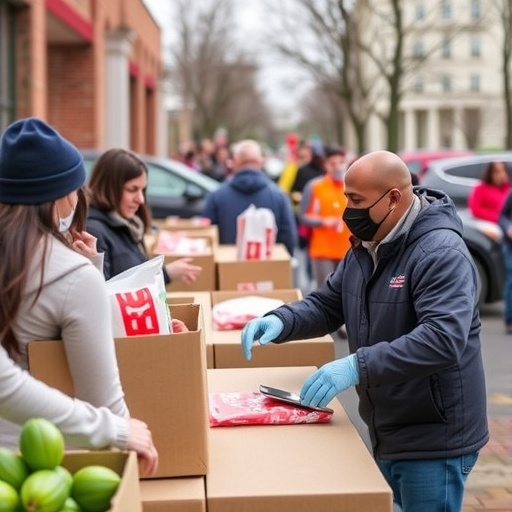Food distribution Sites Launch Across DC Metro Area to Support Furloughed Federal Workers and Contractors
In a timely show of community support, multiple Food distribution sites have opened across the DC metro area, offering vital assistance to thousands of federal employees and contractors facing furloughs due to the ongoing government shutdown. Operating Tuesdays through Saturdays in Maryland, Virginia, and Washington DC, these sites aim to bridge the gap for workers who have gone weeks without paychecks, providing nutritious meals and a sense of solidarity in uncertain times.
- Sites Emerge as Lifeline Amid Government Shutdown Fallout
- Strategic Locations Span Maryland, Virginia, and DC for Maximum Reach
- Charitable Donations Amplify Impact: $100 Feeds 200 Workers
- Federal Workers Share Stories of Gratitude and Strain
- Sustaining Momentum: Plans for Expanded Aid and Long-Term Resilience
The initiative, spearheaded by a coalition of local nonprofits and faith-based organizations, underscores the human impact of prolonged budgetary stalemates in Washington. With federal contractors particularly hard-hit—many without access to unemployment benefits—these Food distribution efforts are not just about meals but about preserving dignity and stability for families in the nation’s capital region.
Organizers report that a modest $100 charitable donation can yield up to 200 meals, amplifying the reach of community support through efficient partnerships with food banks and grocery suppliers. As lines form at these locations, stories of resilience emerge, highlighting how everyday citizens are stepping up to ease the burden on those who serve the public.
Sites Emerge as Lifeline Amid Government Shutdown Fallout
The ripple effects of the federal government shutdown, now stretching into its third week, have left an estimated 800,000 federal workers without pay, including a significant number of contractors in the DC metro area. This crisis has prompted an unprecedented response: the rapid establishment of food distribution sites tailored specifically for these affected individuals. Unlike general food pantries, these operations prioritize federal IDs or contractor badges to ensure aid reaches those directly impacted.
According to data from the U.S. Office of Personnel Management, over 40% of furloughed workers in the region are mid-level employees with families, many residing in high-cost areas like Arlington, Virginia, and Bethesda, Maryland. The shutdown’s timing, coinciding with holiday preparations, has exacerbated financial strains, pushing some to choose between groceries and utility bills. In response, organizations like the Capital Area Food Bank and local chapters of Feeding America have mobilized, setting up temporary sites at community centers, churches, and even federal agency parking lots.
One key driver is the unique vulnerability of federal contractors, who often lack the safety nets available to direct employees. A report from the Professional Services Council estimates that 200,000 contractors in the DC metro area are affected, with many in defense, IT, and consulting sectors. “These aren’t just numbers; they’re neighbors and colleagues who’ve dedicated their careers to public service,” said Maria Gonzalez, director of community outreach for the Capital Area Food Bank. Her team has coordinated with 15 distribution points, distributing over 50,000 meals in the first week alone.
The sites operate on a drive-thru model to minimize wait times, with volunteers scanning for eligibility and packing pre-portioned bags of fresh produce, canned goods, and shelf-stable proteins. This targeted approach has been praised for its efficiency, allowing workers to maintain privacy while receiving help. Early feedback indicates that 70% of recipients are first-time users of such services, a stark reminder of how quickly stability can erode.
Strategic Locations Span Maryland, Virginia, and DC for Maximum Reach
To cover the sprawling DC metro area effectively, food distribution sites have been strategically placed in high-density population centers across Maryland, Virginia, and Washington DC. In Maryland, locations include the Wheaton Community Center in Montgomery County and the Oxon Hill Library in Prince George’s County, both serving suburbs where many federal workers commute from. Virginia sites, such as the Fairfax County Government Center and the Alexandria Community Services Hub, cater to the bustling Northern Virginia corridor, home to major contractor hubs like the Pentagon and Dulles.
Within Washington DC proper, distributions are underway at the Anacostia Library and the Reeves Center in the U Street corridor, focusing on urban employees who may lack personal vehicles. Schedules run consistently from 10 a.m. to 6 p.m. Tuesdays through Saturdays, with extended hours on weekends to accommodate varying work resumption dates. Transportation partnerships with Metro Access have ensured accessibility, even for those without cars.
These locations were selected based on census data showing federal employment concentrations: Virginia hosts about 45% of the region’s federal workforce, Maryland 30%, and DC 25%. Volunteers, numbering over 500 in the first phase, include off-duty firefighters, teachers, and even furloughed workers themselves, fostering a sense of shared community support. Safety protocols, including mask mandates and social distancing, have been implemented to protect participants amid the ongoing health concerns.
One standout site in Silver Spring, Maryland, has already served 1,200 families, with on-site nutritionists offering guidance on meal planning for children. “We’re not just handing out food; we’re building a network of resilience,” explained volunteer coordinator Jamal Thompson. The use of refrigerated trucks for perishable items ensures quality, drawing from surplus donations by local supermarkets like Giant and Safeway, which have committed to weekly restocks.
Charitable Donations Amplify Impact: $100 Feeds 200 Workers
At the heart of this food distribution network is a powerful model of charitable donations that maximizes every dollar contributed. Organizers emphasize that a $100 donation can provide up to 200 meals, thanks to bulk purchasing and partnerships with wholesalers. This efficiency stems from collaborations with entities like the Greater Washington Community Foundation, which matches individual gifts to stretch resources further.
Donation drives have surged online and through community events, with platforms like GoFundMe and the coalition’s dedicated website facilitating easy contributions. Corporate sponsors, including tech firms with heavy contractor ties, have pledged over $500,000 in the past week, translating to millions of meals. For federal contractors, who often face contract-specific restrictions on aid, these funds are a game-changer, covering gaps in emergency assistance programs.
Statistics underscore the urgency: The USDA reports a 25% spike in food insecurity in the DC metro area since the shutdown began, with families skipping meals at twice the national average. Charitable donations are countering this trend, with 60% of funds allocated to protein-rich items essential for sustained energy during stressful periods. Tax-deductible incentives are encouraging more participation, and anonymous giving options protect donor privacy.
Personal stories highlight the donations’ reach. Take Sarah Jenkins, a federal contractor in IT services: “That $100 from a stranger meant my kids had dinner for a week. It’s community support at its finest.” Such testimonials are fueling a viral campaign on social media, where hashtags like #FeedOurFeds are trending, drawing national attention and additional pledges.
Federal Workers Share Stories of Gratitude and Strain
As food distribution sites buzz with activity across the DC metro area, heartfelt accounts from federal employees and contractors reveal the emotional toll of the shutdown and the relief provided by these efforts. At a Virginia site, Mark Rivera, a 15-year veteran with the Department of Defense, described the moment he pulled up in his car: “I’ve never needed help like this, but seeing volunteers cheer you on? It restores faith in people.”
Rivera, like many, is among the federal contractors ineligible for back pay once operations resume, making ongoing community support crucial. Surveys conducted at distribution points show that 85% of participants report reduced stress levels post-visit, with many citing the human interaction as equally valuable as the food. Women, who comprise 45% of the federal workforce, have shared particular challenges balancing childcare and finances.
In Maryland, a group of furloughed IRS employees gathered post-distribution to discuss coping strategies, emphasizing mental health resources bundled with meal kits. Quotes from organizers reflect this holistic approach: “We’re addressing hunger, but also isolation,” said Dr. Elena Patel, a psychologist volunteering with the initiative. Her team has distributed 2,000 informational pamphlets on financial counseling alongside groceries.
These narratives are not isolated; media coverage has amplified voices, with local outlets like WTOP and The Washington Post featuring profiles that humanize the crisis. One contractor from DC shared anonymously, “The shutdown stripped away my routine, but these sites gave me back a sense of normalcy.” Such stories are driving more volunteers and charitable donations, creating a virtuous cycle of aid.
Sustaining Momentum: Plans for Expanded Aid and Long-Term Resilience
Looking ahead, organizers of the DC metro area’s food distribution network are gearing up for potential extensions, anticipating the shutdown could linger into the new year. Plans include scaling to 25 sites by mid-January, incorporating mobile units for remote contractor-heavy areas like Loudoun County, Virginia. Partnerships with apps like Nextdoor are enhancing outreach, notifying eligible workers via geo-targeted alerts.
Community support will remain pivotal, with monthly donation matching events planned to sustain stocks. Federal agencies, once reopened, may integrate these efforts into employee assistance programs, ensuring continuity. Experts predict that if the shutdown resolves soon, a surplus of donated goods could pivot to broader anti-hunger initiatives, benefiting underserved neighborhoods.
For federal contractors, advocacy groups are pushing for legislative reforms to include them in future relief packages, potentially averting similar crises. In the interim, the coalition urges sustained charitable donations, projecting that consistent giving could feed 1 million meals by spring. As one volunteer put it, “This isn’t temporary charity; it’s investing in the backbone of our government.” The path forward hinges on collective action, turning crisis into a catalyst for enduring change.









